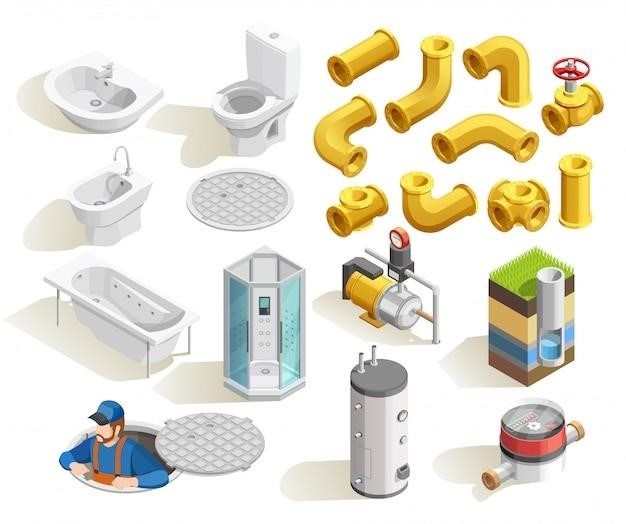Piping Isometric Drawing Symbols⁚ A Comprehensive Guide
Piping isometric drawings are essential tools for fabricators, material purchasers, and field crews. These 3D drawings provide a comprehensive view of piping configurations, dimensions, and connections, ensuring accurate construction and installation. This guide delves into the world of piping isometric drawing symbols, offering a comprehensive overview of common symbols, valve types, piping components, and instrumentation. This resource will equip you with the knowledge to interpret and create piping isometric drawings effectively.
Introduction
Piping isometric drawings are indispensable tools in the realm of engineering, providing a detailed visual representation of piping systems in a three-dimensional format. These drawings are crucial for conveying essential design information to fabricators, construction teams, and other stakeholders involved in the project. They serve as a blueprint for constructing and installing piping systems accurately and efficiently.
The effectiveness of piping isometric drawings hinges on the clear and consistent use of symbols. These symbols act as a visual language, representing various piping components, fittings, valves, and instrumentation. Understanding these symbols is paramount for interpreting the drawings and translating them into practical applications.
This comprehensive guide delves into the world of piping isometric drawing symbols, providing a thorough explanation of their meaning, usage, and significance. It will equip you with the knowledge necessary to decode the intricacies of these drawings and navigate the complex landscape of piping systems with ease.
Importance of Piping Isometrics
Piping isometric drawings play a pivotal role in the success of any piping project, offering numerous benefits that streamline the design, construction, and operation processes. Their importance stems from their ability to provide a comprehensive and accurate representation of complex piping systems, facilitating clear communication and minimizing errors.
One of the key benefits of piping isometrics is their ability to provide a detailed understanding of the entire piping system. They showcase the intricate relationships between pipes, fittings, valves, and other components, revealing the flow of fluids and the intricate network of connections. This comprehensive view allows engineers and technicians to visualize the system in its entirety, enabling them to identify potential issues and optimize design decisions.
Furthermore, piping isometrics serve as a valuable tool for construction teams. They provide precise dimensions and locations of all components, ensuring that the piping system is assembled correctly on-site. This eliminates the need for guesswork and reduces the likelihood of errors, leading to faster and more efficient installation.
Key Features of Piping Isometrics
Piping isometric drawings are distinguished by specific features that make them effective tools for representing complex piping systems. These features ensure accuracy, clarity, and ease of understanding, facilitating efficient communication and coordination among project stakeholders.
One of the defining characteristics of piping isometrics is their use of a 30-degree view. This perspective allows for a realistic representation of the piping system while still maintaining a two-dimensional format. The 30-degree angle provides a balanced perspective, allowing viewers to easily identify pipe lengths, fittings, and connections.
Another key feature is the use of proportionate drawings. While not drawn to scale, piping isometrics maintain accurate proportions between components. This allows for a clear visual representation of the system’s layout, while still providing precise dimensions for fabrication and installation. Additionally, piping isometrics typically break down the system into “spools,” which represent individual sections of piping that can be fabricated and assembled separately. This modular approach simplifies the construction process and reduces the risk of errors.
Piping Isometric Drawing Symbols
The foundation of piping isometric drawings lies in a standardized set of symbols that represent various components, fittings, and equipment. These symbols act as a visual language, allowing engineers, fabricators, and construction crews to communicate effectively and ensure accurate interpretation of the design. Understanding these symbols is crucial for interpreting and creating piping isometric drawings.
Each symbol is designed to represent a specific component, such as valves, flanges, pumps, or instruments. The symbols typically depict the general shape and function of the component, simplifying complex representations into easily recognizable forms. This standardization ensures consistency across different projects and companies, promoting efficient collaboration and minimizing the risk of misinterpretation.
Piping isometric symbols are often based on industry standards, such as ISO (International Organization for Standardization) or ASME (American Society of Mechanical Engineers). These standards ensure that the symbols are universally recognized and understood, promoting clear communication across geographical boundaries and industries.
Common Piping Symbols
Piping isometric drawings rely on a set of standard symbols to represent various components and fittings. These symbols serve as a visual language, allowing for clear communication and accurate interpretation of the piping system. Among the most common symbols are those representing pipe fittings, which play a crucial role in connecting and directing the flow of fluids within the system.
One of the most frequently encountered symbols is the elbow, which is used to change the direction of the pipe. The elbow symbol typically depicts a curved section of pipe, with the angle of the curve representing the angle of the elbow. Other common fittings represented by symbols include tees, which create branching points in the pipe, and reducers, which gradually decrease the diameter of the pipe.
These symbols are often standardized based on industry standards, such as ISO or ASME, ensuring consistent interpretation across projects and companies. A comprehensive understanding of these common piping symbols is crucial for accurately interpreting and creating piping isometric drawings, facilitating effective communication and collaboration within the engineering and construction sectors.
Valve Symbols

Valves are essential components in piping systems, controlling the flow of fluids and preventing unwanted backflow. In piping isometric drawings, specific symbols are used to represent various valve types, providing visual information about their function and configuration. These symbols are crucial for understanding the operation and maintenance of the piping system.
One common valve symbol is the gate valve, which typically depicts a rectangular shape with a vertical line representing the valve stem. Gate valves are used for on/off control and allow for full flow when open. Another frequently encountered symbol is the globe valve, represented by a circular shape with a curved stem. Globe valves offer more precise flow control than gate valves and are often used for throttling applications.
The choice of valve symbol depends on the specific valve type being represented, with each symbol conveying information about the valve’s function, operation, and connection type. Understanding these symbols allows for accurate interpretation of the piping system’s flow control mechanisms, ensuring efficient operation and maintenance.
Piping Component Symbols
Piping isometric drawings rely on a system of symbols to represent various components that make up the piping system. These symbols provide essential information about the type, size, and configuration of each component, enabling accurate fabrication and assembly.
One common symbol is the elbow, which is typically represented by a curved line indicating the angle of the bend. Elbows are used to change the direction of the pipe run and are available in various angles, including 45 degrees, 90 degrees, and 180 degrees. Another frequently encountered symbol is the tee, depicted as a “T” shape, connecting three pipe runs. Tees allow for branching or merging of pipe lines.
These symbols are vital for communicating the design intent and ensuring the proper selection and installation of piping components. Understanding these symbols is essential for both creating and interpreting piping isometric drawings, contributing to the efficient and accurate construction of piping systems.
Instrumentation Symbols
Piping isometric drawings often incorporate symbols representing various instrumentation components that monitor and control processes within the piping system. These symbols are essential for conveying the functionality and location of instrumentation devices, ensuring proper integration and operation.
Common instrumentation symbols include those for pressure gauges, temperature sensors, flow meters, and level indicators. These symbols are typically depicted using standardized shapes and markings, ensuring consistent understanding across different drawings and projects. For instance, a pressure gauge might be represented by a circle with a “P” inside, while a temperature sensor might be depicted as a circle with a thermometer symbol.
Understanding these instrumentation symbols is crucial for engineers, technicians, and operators involved in the design, installation, and maintenance of piping systems. These symbols provide critical information about the location and function of instruments, enabling informed decision-making and ensuring the safe and efficient operation of the process.
Understanding Piping Isometric Drawings
Piping isometric drawings are not just a collection of lines and symbols; they are a language that conveys crucial information about a piping system. To decipher this language, it’s essential to understand the key elements and conventions used.
The core of a piping isometric is its 3D representation. The drawing uses a 30-degree angle view, allowing for a realistic depiction of the piping layout, including its orientation and spatial relationships. This helps to visualize how pipes connect and interact with other components;

Dimensions are a critical part of these drawings. They indicate the precise lengths of pipes, the sizes of fittings, and the distances between components. These dimensions ensure that fabricated parts fit together accurately during construction. Additionally, elevation marks provide information about the vertical position of piping elements, crucial for ensuring proper drainage and flow.
A thorough understanding of piping isometric drawings is vital for everyone involved in the construction and operation of piping systems. It ensures accurate fabrication, installation, and maintenance, ultimately contributing to the safe and efficient functioning of the entire process.
Mastering piping isometric drawing symbols is a critical skill for professionals in the engineering and construction industries. These symbols are the foundation of communication, enabling clear and concise documentation of piping layouts. By understanding the meaning behind each symbol, you can effectively interpret and create isometric drawings, ensuring accurate fabrication, installation, and maintenance of piping systems.
From common piping components like valves and fittings to specialized instrumentation, each symbol plays a crucial role in conveying design intent and facilitating smooth project execution. This comprehensive guide has provided a solid foundation for understanding these symbols, empowering you to navigate the world of piping isometrics with confidence.
As you continue your journey in piping engineering, remember that ongoing learning and familiarity with industry standards are essential. Embrace the power of these symbols to communicate effectively and contribute to the success of your projects.
